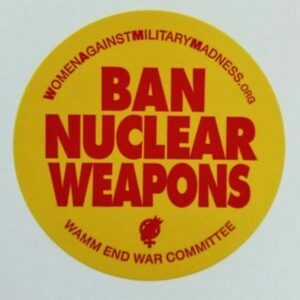The danger of nuclear weapons has not gone away. If anything, it’s worse than it was at the height of the Cold War.
Modernizing Nuclear War
Dr. Strangelove is still with us in a new generation of the masters of war. (Peter Sellers in Stanley Kubrick’s 1964 Cold War film. Columbia Pictures)
by Joel Weisberg /
The term nuclear “modernization” is actually a euphemism and fig leaf for significantly upgrading weapons with the frightening idea of fighting and winning a nuclear war. It also brings with it the attendant dangers of deploying the new weapons. This article focuses on the U.S., because much more information is available and also because its announced modernization plans are much more grandiose, though the other great powers, Russia and China, are engaged in competing, if smaller, modernization plans.
First, in order to have some sense of the size of this project, it is crucial to note that the U.S. plans to spend over 1.5 trillion dollars (which is more than one-million million dollars!) on this effort in the next decade or so, not to mention the ongoing maintenance costs running far into the future. Not surprisingly, cost estimates for much of the planned modernization have already escalated tremendously in the last several years. Antiwar activists will shudder at the waste of resources that these sums represent, not to mention the horror that will ensue if even a fraction of available nuclear weapons (whether current ones or “modernized” replacements) are ever used – e.g., the soot from burning cities and forests, even from a “limited” nuclear war, would block the sun for a long period, leading to loss of crops, starvation, and mass death, in what is called a “nuclear winter.”[1]
According to a 2022 study by Lili Xia, et al in the scientific journal Nature Food, a “limited” nuclear war involving a “mere” 100 Hiroshima - or Nagasaki-sized weapons is estimated to cause 255 million people to have no food two years after the war. Note that a single U.S. missile submarine, of the 12 at sea at any given time, carries approximately this much explosive energy in its onboard nuclear weapons as it cruises the world’s waterways.[2]
Fatalities from the direct causes, alone, in a limited nuclear war would be 27 million people and would themselves be more catastrophic to life on earth than any event since the dinosaur-killing asteroid impact about 65 million years ago.
In the worst-case scenario - a war using most of the nuclear weapons of the U.S. and Russia, 360 million people would die from direct causes and about five billion would be starving at the two-year mark. The full arsenal of China would cause proportionately smaller (yet still devastating) consequences, since its nuclear cache is much smaller than those of the two nuclear superpowers.
 Paypal/Card Other Options
Paypal/Card Other Options
Support Independent Media
Even as we recoil from these thoughts, we need to assume what’s in the minds of professional nuclear war planners for the purpose of understanding their rationales. Some U.S. nuclear analysts claim that the mere existence of U.S. nuclear forces deters other nations from attacking. The chilling and absurd claim that these weapons can actually be used for fighting and winning a nuclear war is another rationale less well known to the public. According to this logic, the “modernization” of nuclear weapons systems will render them more effective and deadly.
What are the components of the modernization program? There are four: the three means of delivering nuclear bombs: by land, sea, and air, which the U.S. Department of Defense refers to as the “Nuclear Triad.” And then there are the nuclear bombs themselves. The estimated size of each category for the U.S., Russia, and China is listed in the table.
The Delivery Systems of the Nuclear Triad
from land: Intercontinental Ballistic Missiles (ICBMs)
ICBMs are rockets that can travel from one continent to another in less than an hour, carrying from one to a dozen or so individual nuclear warheads, each of which can be aimed at a different target.
They are housed in underground, concrete-lined “silos,” which should prevent their destruction in war unless they suffer a nuclear bomb hit on or above a silo. Unfortunately, a direct hit is exactly what can happen. Recent advances in targeting accuracy permit ICBMs to land and detonate right atop their adversary’s silos and the missiles harbored inside them.
This development renders them vulnerable to destruction in a surprise attack, only a few minutes after it would be initiated. It puts great pressure on the military commanders in charge of these weapons to launch them immediately upon the warning of an attack and before they are absolutely sure that it is real. (Once launched, they would be safe from the attack.) Such policies, aptly called “Launch on Warning,” place the whole world at risk of nuclear destruction due to accident or miscalculation.
Furthermore, because it’s possible to wipe out an enemy’s ICBMs in their silos before they can be used, their bases become principal targets of an aggressor nation. The U.S. component of 400 ICBMs and their silos is located in Colorado, Wyoming, Nebraska, Montana and North Dakota, so one of the consequences of an attack upon them would be the creation of catastrophic quantities of deadly radioactive fallout drifting - depending on the direction the wind is blowing - toward the upper Midwest, including Minnesota.
The Nuclear Triad Delivery System
Image: Defense Logistics Agency
A December 2023 Scientific American article indicates that more than a million Americans would die shortly after an all-out Russian attack on these silos alone, mostly from fallout-induced radiation sickness. Only the comparatively sparse population density of the upper Midwest - in contrast to the rest of the United States - would prevent a much higher toll.
Most experts agree that the current force of 400 U.S. Minuteman III ICBMs will remain potent for decades and can remain so for additional decades if modest maintenance measures are implemented. Yet many billions of dollars are slated to be spent to replace them with a new set of ICBMs, called “Sentinels.”
What a colossal waste, to replace well-functioning devices with an expensive new generation, even if one were to grant the necessity of their existence at all! Nevertheless, the program keeps barreling on not least because all senators from states hosting missiles are strong supporters of the Sentinel program and have even formed an unofficial “ICBM Coalition” to lobby for it. Apparently, they are more interested in the limited number of jobs generated by the ICBM than in avoiding having their home states act as “nuclear sponges” in the event of war!
In contrast, more sober nuclear weapons analysts suggest that the best solution to the problem of ICBM vulnerability to attack is simply to eliminate them, and to rely solely on the other two means of nuclear weapons delivery. See the “Deployed” Table at the end of this article: the large numbers of weapons in the other two categories suggest that more than enough would still exist to satisfy the “need” to deter opponents’ attacks. These other two categories are:
by sea: Submarine Launched Ballistic Missiles (SLBMs)
SLBMs are similar to ICBMs, except that their basing in submarines allows them to have shorter ranges (since a submarine can sneak close to the opponent’s shores), and to be smaller in size (to fit into a submarine’s cramped quarters). The great advantage of SLBMs is that submarines are hard to detect and attack, so their missiles need not be launched quickly in order to avoid destruction upon (possibly faulty) warning of attack. This gives the crew of the submarine precious time to evaluate the reality of the supposed attack. In this fashion, they are considered more reliable mode of nuclear weapons delivery than ICBMs are.
SLBMs and their hosting submarines are also slated for “modernization” and replacement.
by air: Bombers
Bombers, not unlike airliners, are relatively slow and vulnerable to attack over their opponent’s territory. But they, like SLBMs, need not release their warheads immediately, which gives commanders a chance to assess the reality of a possible attack before the bombs are used. A new generation of bomber, the B-21 Raider, is in the works.
The Bomb
Warheads
A set of three Minuteman III ICBM nuclear warheads, each of which is nestled inside its own cone-shaped housing. Note for scale: the coffee table-like structure underneath them. The whole structure was housed atop a single missile (nose-cone pictured on left), and each warhead was aimed at a separate target.
Image is from the Nuclear Weapons Graphics Project which was created by Mike Casper and managed by WAMM member Nancy Casper.
Since 2014, as a result of arms control (New START), every U.S. ICBM was limited to carrying only a single warhead, each with explosive energy equal to that of about 20 Hiroshima or Nagasaki bombs.
Modern nuclear warheads, which the new delivery systems will be hosting, release far more energy than did the original bombs that were dropped on Hiroshima and Nagasaki. Those WWII bombs were powered by splitting the heavy nuclei of uranium or plutonium. (This process is what’s referred to as the “splitting of the atom” powering those types of nuclear bombs, which are therefore sometimes called “A-bombs.”)
In contrast, today’s modern nuclear bombs generate most of their energy by ramming together the nuclei of light elements such as hydrogen. For those who watched the recent movie, Oppenheimer, this bomb was called the “H-bomb” or the “Super,” and it was Oppenheimer’s opposition to its being built that led to his downfall and the loss of his security clearance. He and some other weapons scientists believed that H-bombs were so powerful that they would lead literally to overkill: meaning that one H-bomb could kill many more people or destroy most military targets many times over.
A modern H-bomb actually requires that a fission bomb (A-bomb) be exploded first in order to trigger the much more powerful fusion reaction. The fission bomb that initiates the fusion reaction is called a “trigger,” “pit” or “core,” whose active part is usually a grapefruit-sized sphere of plutonium. (Yes, the guts of a highly destructive modern nuclear fusion bomb are roughly the size of a grapefruit! All the rest of what constitutes a modern fusion/H-bomb is usually about ten times larger, or about the size of a person.)
There is some concern that the plutonium core will degrade over the course of decades, thereby perhaps not being effective enough to trigger the H-bomb, or at least not as well as planned.
There is much disagreement among experts as to whether or not this plutonium “aging” process is significant enough to render some fraction of the H-bombs inoperable, but those committed to the “finest” possible weapons do not wish to take any chances. As a result, hundreds of billions of dollars will be spent on creating new plutonium cores, primarily in factories at Savannah River, Georgia, and Los Alamos, New Mexico (where the very first plutonium bombs were built). Both facilities are currently decrepit, so tremendous costs will be incurred to renovate them.
Sadly, although the New Mexico and Georgia Senators all range from fairly to very progressive, potential jobs seem once again to trump everything else. Therefore, all of these senators are vociferous supporters of the plutonium factories in their home states. Apparently, these senators have been captured by economic arguments and interests, much as the (mostly right-wing) ICBM Senate Coalition has been.
Another significant factor is the influence of defense contractors who lobby members of Congress, many of whom sit on key committees positioned to make decisions about modernizing weapons. In advance of the 2024 federal defense budget (the NDAA, or National Defense Authorization Act), $70 million was spent lobbying senators and representatives of both parties. and from states throughout the U.S.[3]
With factors like these, is it any wonder that the immense costs of the planned modernization of the four principal components of the strategic nuclear weapons program are a staggering 1.5 trillion? Even if one accepts the need for nuclear weapons (which many of us do not), the upgrades are unnecessary. For at least one category, (ICBMs), its total elimination would provide more security than would an upgrade. In our efforts to see a world without any nuclear weapons, we activists need to do all we can to prevent the waste and enhanced dangers associated with the planned modernization.
Note that even the four components of nuclear weapons and their delivery vehicles described in this article are not the whole story. There is also an immense military infrastructure supporting these devices, including, for example, spy satellites, missile, and satellite interceptors. (In the next issue of Women Against Military Madness Newsletter: a look at one element that has been in the media recently - the newly revealed Russian space technology that is making people agog.)
Deployed* U.S., Russian, and Chinese strategic (long-range) delivery vehicles and warheads
| Intercontinental Ballistic Missiles (ICBMs) and warheads deployed | Submarine Launched Ballistic Missiles and warheads (SLBMs) deployed | Intercontinental Bombers and warheads deployed | |
| U.S. | 400 and 400 | 240 and 1000 | 50 and 300 |
| Russia | 321 and 834 | 176 and 640 | 55 and 200 |
| China | 142 and 240 | 72 and 72 | 474 and 410 |
*Large numbers of most categories are also held in reserve and are not counted here. Totals do not include “tactical” (short-range) delivery vehicles or warheads. Source: U.S., Russian, and Chinese “Nuclear Notebooks,” 2023, Bulletin of Atomic Scientists, authors Hans M. Kristensen, Matt Korda, and Eliana Johns.
Joel Weisberg is the Stark Professor Emeritus of Physics and Astronomy and the Natural Sciences, Carleton College




